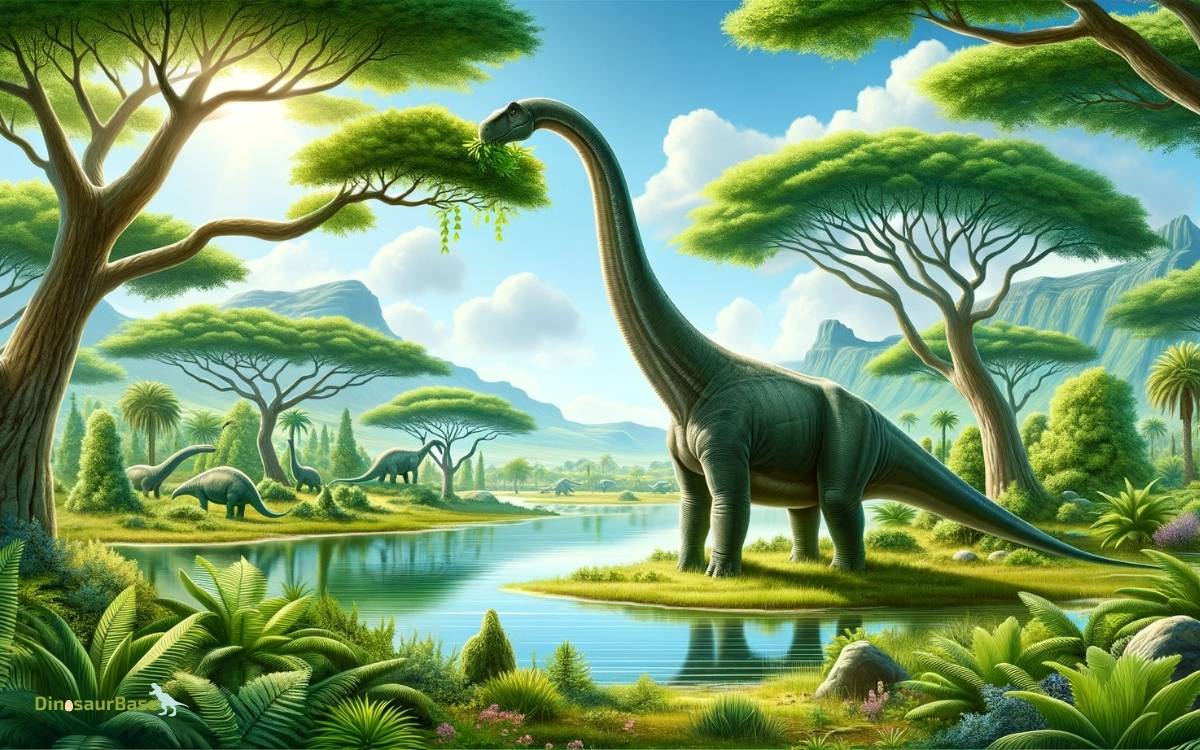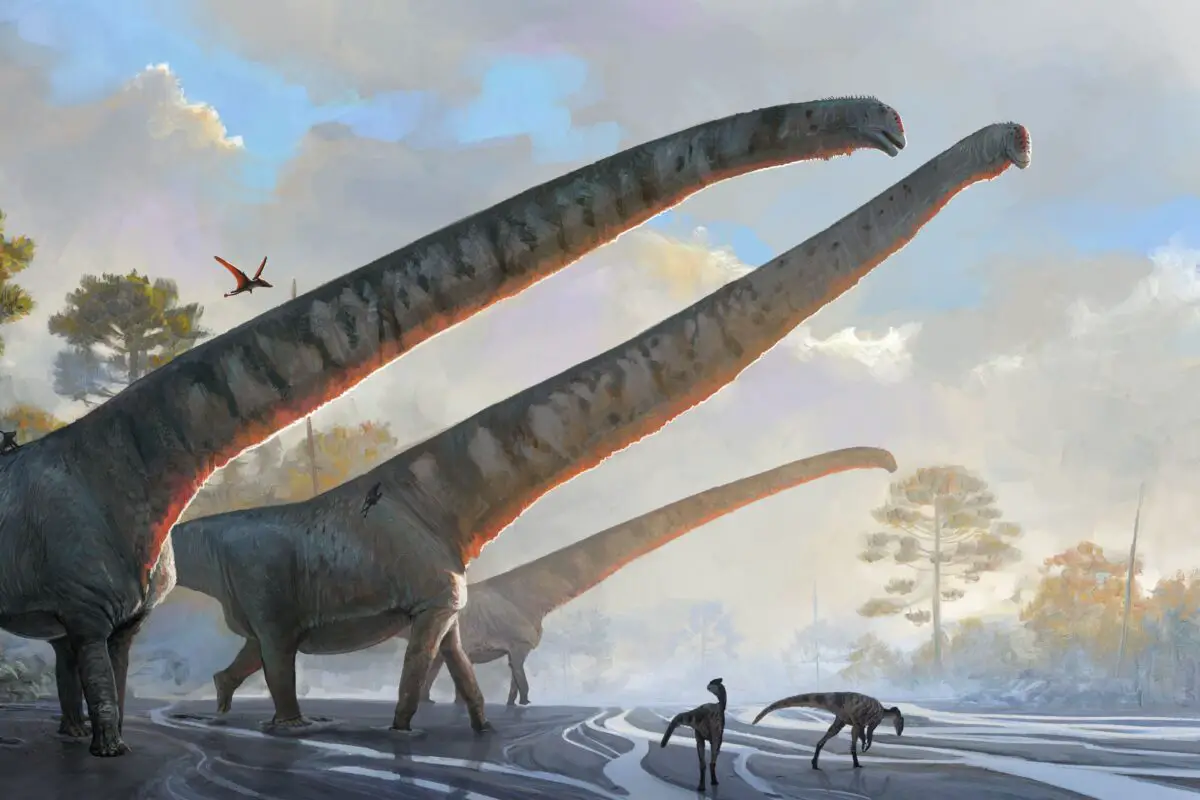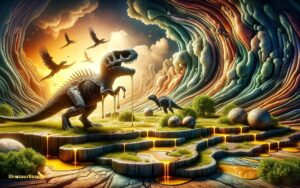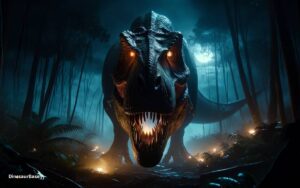How to Identify a Dinosaur That Has a Long Neck
To identify a dinosaur with a long neck, look for an elongated neck with numerous vertebrae. These dinosaurs also tend to have small heads in proportion to their necks.
Dinosaurs that sport long necks are among the enchanting giants of the prehistoric world. Known as sauropods, these creatures roamed the Earth in the Mesozoic Era. Enthusiasts and paleontologists often marvel at their distinctive physiognomy which includes not just the iconic neck, but also a hefty body and a long tail.
Finding such dinosaurs in the fossil record excites the scientific community, as it provides deeper insights into dinosaur biology and the ecosystems of ancient times.
Recognizing the long-necked varieties is straightforward if one knows the key features that set them apart. This knowledge helps in understanding the vast array of dinosaur species and their evolution.

The Allure Of Long-necked Dinosaurs
Imagine seeing a creature with a neck longer than a school bus! Such giants once roamed our planet. Long-necked dinosaurs never fail to capture our imagination.
Their incredible size and striking appearance set them apart in the prehistoric world. Discover the giants that stood tall above the rest.
Icons Of Prehistoric Size
Dinosaurs with long necks belong to a group called Sauropods. These were some of the largest animals to walk the earth.
Their long necks helped them reach high and low vegetation, giving them an advantage in the prehistoric landscapes. Let’s meet some of these icons:
- Brachiosaurus: Stood at 50 feet tall with a neck that could stretch to 30 feet.
- Diplodocus: Known for its whip-like tail and a neck that stretched up to 26 feet long.
- Argentinosaurus: Might have been the largest of them all, with estimates suggesting a length of over 100 feet.
Fascination Across Generations
Sauropods have dazzled not just scientists but everyone, young and old. Storybooks and movies bring these ancient beasts to life.
The thought of such massive creatures walking our planet excites the mind and fuels the imagination of generations.
Their grandeur has a universal appeal, seen in:
| Media | Impact on Generations |
|---|---|
| Films | Sparks wonder through visual storytelling. |
| Books | Encourages learning and discovery. |
| Toys | Engages young minds in prehistoric play. |
Anatomy Of Giants

Imagine walking through a forest, and you see a towering creature with a neck so long, it rises above the treetops.
Such a sight belonged to the Mesozoic Era, when dinosaurs named sauropods roamed Earth.
These gentle giants are known for their long necks and impressive size. Let’s explore how to identify these prehistoric marvels, starting with their defining characteristics.
Characteristics Of Sauropods
Sauropods were remarkable in both size and stature. The term ‘sauropod’ means ‘lizard foot’ in Greek.
These dinosaurs were herbivores with specific traits:
- Massive Bodies: They had huge, barrel-shaped torsos to digest large amounts of plant material.
- Gigantic Legs: Their legs were column-like, resembling pillars, to support their weight.
- Enormous Necks: They are best known for their elongated necks, which allowed them to reach high vegetation.
- Long Tails: Their tails were extended and powerful, used for balance or defense.
Distinct Skeletal Features
Sauropods’ skeletons were unique, consisting of several distinctive features:
| Skeletal Part | Distinct Feature |
|---|---|
| Vertebrae | Had air spaces making them lighter |
| Ribs | Extremely long to support the giant torso |
| Limbs | Straight and sturdy, with large limb bones |
| Skull | Relatively small with nostrils on top of the head |
This distinct anatomy allowed sauropods to thrive. Their skeletal structure was a masterpiece of evolution, perfectly designed for their size and lifestyle. Next time you visit a museum, look for these bone patterns to identify a sauropod.
Notable Long-neck Dinosaur Species
Imagine walking through a landscape dotted with towering creatures, their long necks reaching up into the foliage.
These are the long-neck dinosaurs, a group that always captures our imagination. Among these giants, certain species stand out for their fascinating features and massive sizes.
Brachiosaurus And Its Unique Posture
Brachiosaurus, one of the most well-known long-necks, walked the Earth in the Late Jurassic period.
With a name that means “arm lizard”, this dinosaur had front legs that were longer than its hind legs. This gave it a stance unlike any other dinosaur, resembling a giraffe today.
- Upright stance: helped it to reach high into trees
- Neck length: estimated to be over 9 meters (30 feet)
- Height: it stood at about 13 meters (43 feet) tall
Diplodocus: Length Versus Height
The Diplodocus presents a different kind of wonder. Rather than striving for height, it stretched out its length. Its neck spanned across vast distances and trailed by a whip-like tail.
This incredible dinosaur lived alongside Brachiosaurus but followed a very different design principle.
| Diplodocus Feature | Details |
|---|---|
| Total Length | Could reach up to 33 meters (108 feet) |
| Neck Length | Approximately 8 meters (26 feet) |
| Height | Not as tall, focused on horizontal reach |
These species paved the way for understanding the diversity and adaptability of dinosaurs. Their long necks were not just for show but served essential purposes. Brachiosaurus could graze on treetops while Diplodocus swept the lower plains, each using their long necks to explore different niches of their prehistoric world.

Credit: www.sci.news
Fossil Identification Basics
The thrill of discovering dinosaur fossils can ignite the imagination of both scientists and enthusiasts alike.
Identifying a long-necked dinosaur, known as a sauropod, begins by examining fossilized remnants. This section explores the basics of identifying these gentle giants through their fossil records.
Differentiating Cervical Vertebrae
To identify a long-necked dinosaur, the cervical vertebrae are key. These are the bones that make up the neck.
- Size: Long-necked dinosaurs have larger vertebrae than their shorter-necked relatives.
- Structure: Look for elongated vertebrae with large spaces for air sacs.
- Quantity: A higher number of neck bones often indicates a longer neck.
Analyzing Footprint Patterns
Fossilized footprints offer clues to a dinosaur’s identity. Here’s what to look for:
- Shape: A long-necked dinosaur leaves a footprint with a round “ball-like” impression and a narrow mark from the claws.
- Size: Wide spacing between footprints suggests a massive body supported by a long neck.
- Pattern: The alternating pattern of a four-footed dinosaur is different from a two-footed one.
Contributions Of Paleontology
The field of paleontology has unlocked the prehistoric world in ways we never thought possible. This science has enabled us to trace back millions of years to understand creatures like the long-necked dinosaurs. Here, we explore the compelling contributions of this field.
Historic Discoveries And Excavations
Our knowledge of dinosaurs began centuries ago. Human curiosity led to the discovery of giant bones buried deep in the earth.
Many of these belonged to long-necked titans, also known as sauropods. Scientists study old bones to learn about these creatures.
- Sauropods are known for their gigantic size.
- Their necks could be up to 50 feet (15 meters) long.
- Historic digs have unearthed fossils worldwide.
Modern Technological Advancements In Research
In recent years, technology has revolutionized the study of dinosaurs. CT scans and 3D modelling help scientists peek inside fossils without damaging them.
They see the textures and shapes of ancient bones with digital tools. This helps them make accurate models of dinos.
- CT scans provide cross-sectional views of fossils.
- 3D printing allows for the recreation of bone structures.
- Complex software predicts how these giants moved and ate.
With every technological stride, we come closer to how these creatures lived. Paleontology gives us the tools to unveil the mysteries of the long-necked giants that roamed the earth millions of years ago.

Credit: www.mydinosaurs.com
Visiting Long-necked Wonders Today
Imagine standing beneath the towering neck of a dinosaur, its head grazing the treetops. These gentle giants of the past fascinate many.
Today, we can still marvel at these long-necked saurians, known as sauropods, through different means.
Museums and technological advancements bring us face-to-face with creatures like Brachiosaurus and Diplodocus. Let’s explore how you can meet these incredible dinosaurs in our modern world.
Museum Exhibits Around The World
Museums showcase real fossils and full-scale replicas of long-necked dinosaurs. With curated displays, they tell stories of Earth’s ancient inhabitants.
Here are some spots where you can witness these titans:
- American Museum of Natural History, New York: Home to a 94-foot long Apatosaurus.
- Field Museum, Chicago: See a towering Brachiosaurus cast welcoming visitors.
- Natural History Museum, London: Walk beneath a Diplodocus cast, a star attraction.
These exhibits help us understand the scale and lives of sauropods. They include interactive displays and fun facts for all ages.
Virtual Reality And 3d Models
Can’t travel to a museum? Virtual reality (VR) and 3D models offer an immersive experience from your home.
Highlights include:
- Online Virtual Tours: Museums offer 360-degree views of exhibits.
- VR Apps: Apps like ‘Jurassic VR’ transport you to prehistoric times.
- 3D Skeleton Puzzles: Assemble a dinosaur with 3D puzzles online.
These technologies provide a unique, hands-on approach to learning. They recreate the awe of standing next to a real dinosaur, without the travel.
Whether in person or through technology, interacting with long-necked dinosaurs is a thrilling experience. These exhibits and virtual experiences keep the wonder of sauropods alive.
Does a Long Neck Automatically Make a Dinosaur?
The identification of dinosaurs is not solely based on their long necks. Many dinosaurs, like the Triceratops, lacked this feature. The overall body structure, skeletal remains, and other physical attributes are considered to correctly identify a dinosaur species. A long neck does not automatically make a dinosaur.
Frequently Asked Questions Of How To Identify A Dinosaur That Has A Long Neck
What Type Of Dinosaur Has A Long Neck?
Sauropod dinosaurs are known for their long necks. Examples include Brachiosaurus, Apatosaurus, and Diplodocus. These herbivorous giants roamed the earth during the Mesozoic Era.
Do Long Neck Dinosaurs Exist?
Yes, long-necked dinosaurs, called sauropods, such as Brachiosaurus and Diplodocus, roamed the Earth millions of years ago. Their fossils provide evidence of their existence.
What Is The Insect That Looks Like A Long Neck Dinosaur?
The insect resembling a long-neck dinosaur is the giraffe weevil, native to Madagascar, characterized by an extended neck.
What’s The Difference Between A Diplodocus And A Brachiosaurus?
The Diplodocus had a longer tail and neck, with its nostrils on top of its head, while the Brachiosaurus featured a shorter tail, a longer neck, and its nostrils high on its forehead. Brachiosaurus was also taller and heavier than Diplodocus.
Conclusion
Identifying long-necked dinosaurs is both fascinating and educational. Embrace the adventure of discovery by examining features like vertebrae size, neck length, and footprint patterns.
Always cross-reference with reputable paleontology resources to ensure accuracy. Your journey in understanding these ancient giants begins with these steps.
Happy exploring!






